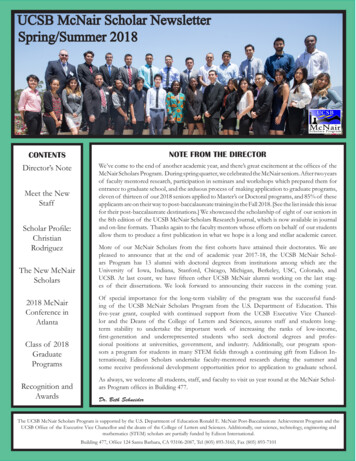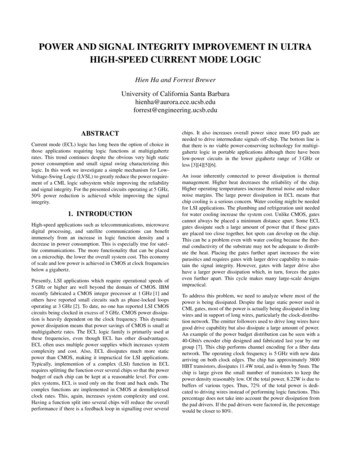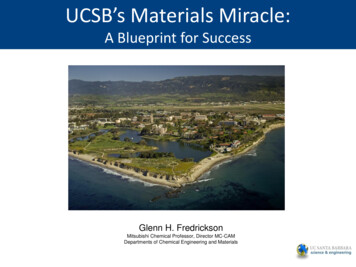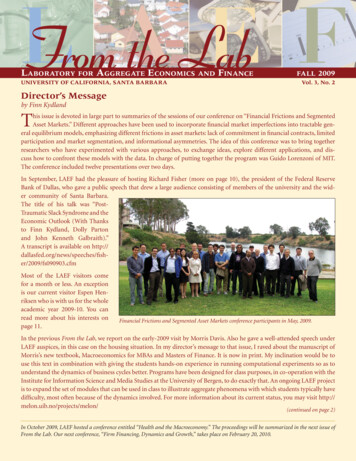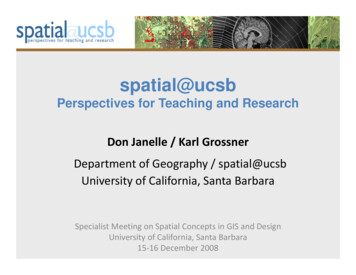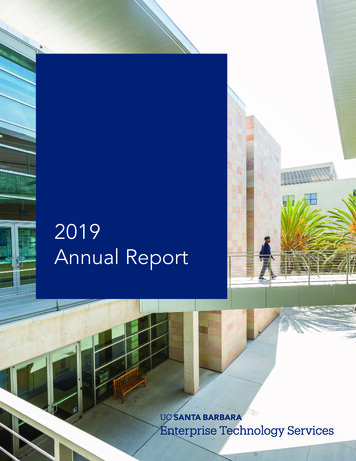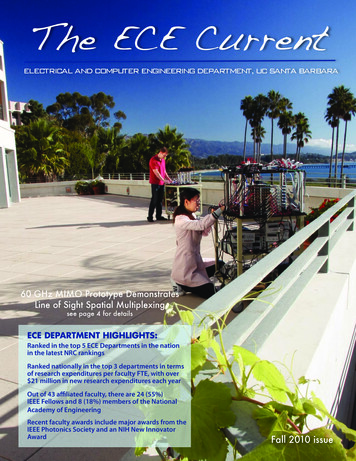
Transcription
The ECE CurrentELECTRICAL AND COMPUTER ENGINEERING DEPARTMENT, UC SANTA BARBARA60 GHz MIMO Prototype DemonstratesLine of Sight Spatial Multiplexingsee page 4 for detailsECE DEPARTMENT HIGHLIGHTS:Ranked in the top 5 ECE Departments in the nationin the latest NRC rankingsRanked nationally in the top 3 departments in termsof research expenditures per faculty FTE, with over 21 million in new research expenditures each yearOut of 43 affiliated faculty, there are 24 (55%)IEEE Fellows and 8 (18%) members of the NationalAcademy of EngineeringRecent faculty awards include major awards from theIEEE Photonics Society and an NIH New InnovatorAwardFall 2010 issue
News FlashResults are in:National Research Councilranks department in Top 5According to the assessment released by theNational Research Council (NRC) on September 28,2010, the ECE Department ranks among the top 5 ECEdepartments in the nation.The NRC collected data on 20 program characteristicsand provided rankings using two different weightingsof these characteristics, the R-ranking and the S-ranking.The ECE Department at UCSB is 5th according to theR-ranking and 4th under the S-ranking.The UCSB Graduate Division’s NRC Assessment ofResearch Doctoral Programs provides a summary thatalso includes all departments in the College. Also theChronicle of Higher Education has a site which allowscomparisons between programs by category.By any ranking that weights research productivity asmeasured by publications per faculty, citations, andpercentage of faculty with research grants, the ECEDepartment ranks in the top 5 or higher.For more information about UCSB’s rankings, visitwww.graddiv.ucsb.edu/nrcProfessor Luke Theogarajan receivesNational Institutes of HealthNew Innovator AwardECE Assistant Professor LukeTheogarajanreceivedtheprestigious 2010 New InnovatorAward from the NationalInstitutes of Health (NIH) for hisresearch on optimal neuralprosthetic devices to restoreneural functions. He is one ofonly 52 such award winners outof 2,200 applicants and one ofonly a few engineers designatedas direct recipients of the 1.5million research award.Theogarajan has been at UCSB for two years and came from MIT,where he received his Ph.D. While at MIT he worked on a retinalprosthesis project: an electronic implant to restore vision tothe blind. He has continued and expanded that research sincehis arrival at UCSB, where he works in three areas: electricalengineering, microfabrication and materials, and pure chemistry.“I like the fact that it’s truly interdisciplinary here,” he said. “Thereis no other place where I could find such openness to research. “Professor Mark Rodwell honored with Doluca FamilyEndowed ChairIt is with great excitement that the department announces the appointment of Dr. MarkRodwell to the Doluca Family Endowed Chair in Electrical and Computer Engineering. TheChair was established as a legacy in honor of the Doluca family and is intended to functionas part of an overarching vision of building leadership and synergy in research focused onanalog/mixed-signal circuit design, and complement and leverage existing research effortsat UC Santa Barbara. It is the desire of the generous benefactors, Tunc and Lale Doluca, thatthe endowed chair be bestowed upon an outstanding scholar who embodies a passion andworld-renowned research expertise in analog/mixed-signal circuit design.Mark Rodwell is an ECE professor and also directs both the SRC Nonclassical CMOSresearch center and the UCSB Nanofabrication laboratory and its participation in the NSFNational Nanofabrication Infrastructure Network (NNIN). He received his Ph.D. in ElectricalEngineering from Stanford University in 1988 and worked at AT&T Bell Laboratories during1982-1984. Professor Rodwell’s research group works to extend the operation of electronicsto the highest feasible frequencies. Their research thus includes semiconductor devices (diodes & transistors), semiconductorfabrication process, circuit design, interconnects, instruments, and communications systems. Particular interests include THz InPbipolar transistors, nm III-V MOSFETs for both VLSI and THz applications, and IC design above 50 GHz in both III-V and Silicon VLSItechnologies.Professor Rodwell received the 2010 IEEE Sarnoff Award and the 2009 IEEE IPRM Conference Award for the development of InP-basedbipolar IC technology, at both device and circuit design level, for mm-wave and sub-mm-wave applications. His group’s work onGaAs Schottky-diode ICs for subpicosecond / mm-wave instrumentation was awarded the 1997 IEEE Microwave Prize and the 1998European Microwave Conference Microwave Prize. Professor Rodwell was elected IEEE Fellow in 2003.2
Alumni SpotlightDenni sM o n t i ce l l iDennis Monticelli received his BSEE from UCSB in 1974 and joined National SemiconductorCorp. upon graduation. For 16 years he worked on a wide variety of analog and mixed signaldevelopment projects, both as a circuit designer and as Design Manager. He was selectedto lead the newly formed Power Management business unit in 1991, promoted to VicePresident in 1995, and named National Fellow in 2000. He currently serves as CTO for NationalSemiconductor with responsibility for strategic planning of technology, collaborative research,and business development.Q: Why did you choose UCSB over other colleges?A: I think the primary reason was that there was a teacher at my high school that hadattended UCSB in the very early years and he spoke very highly of the education I wouldget there. He knew the educators and knew their dedication to teaching and he said for anundergraduate education, you will get as good or better there and probably more professorattention than some of the other campuses.Q: What was a pivotal moment or class for you at UCSB?A: When I started taking graduate classes in my senior year, it was then that I discovered theworld of integrated circuits and what was happening. Really a revolution was in progress and Iwanted to be a part of that. It really dictated where I went when I entered the industry.Q: How has the knowledge you gained in the ECE department helped you at National?A: Well certainly the fundamental grounding you get in your undergraduate years isimportant. I’ve saved a lot of my course notes. And then there is the specialization. Ispecialized in semiconductor devices and circuits my final year and that became my career. So that was extremely instrumental interms of making me attractive to companies and hit the ground running when I came here.Q: Since you’ve been working at National, what has been one of your proudest moments?A: I’ve been here a long time, so there is a lot of history here at National. In terms of what I’m the most proud of, on the technicalside of my career, which is the longest arm in my career, probably developing the world’s first high performance CMOS OperationalAmplifier. That was a turning point, not only for the company but also for the industry. That was a big deal. That was back in 83. Thenon the business side of my career, it’s founding and growing the power management business unit. It grew into the biggest businessunit in the company and today represents over half our revenue.Q: Do you still work with the College of Engineering?A: More recently there has been a fair amount of discussion going on about collaborations in the areas of 3-5 materials, especiallygallium nitride transistors for applications in power, which is a new application for GaN as opposed to the traditional high frequencyapplication: power amplifiers for communication. We are talking power conversion, energy efficiency.Q: How would you say we as a department could better serve our students?A: Internship opportunities are something I’m very positive on. I help drive that here at National Semiconductor. The more anydepartment can do to encourage these internships the better. And theyseem to be most valuable at the graduate level, both masters and PhD.Q: What advice would you give to students in the College of Engineering?A: Make sure that engineering is something you enter in for all the rightmotivations. It really should be something that you derive energy from,you’re passionate about, and something that you would be willing toreally stick to. It has to have some intrinsic connection with you. And asfor courses, when you’re an undergrad, be broad, even if you have a prettygood idea of what you want to specialize in. This is your opportunity tosample a lot of things. Find your passion, stay uncommitted for a while, andthen go for it. Really go for it.Dennis Monticelli and Roger Wood at the 2008 ECEAlumni, Parent and Family Event(San Jose Museum of Art)
Major Research Initiatives60 GHz wireless networkingDid you know?The ECE Budget OfficeManages research spending activity of approximately 21.5million per year on over 240 active extramurally-funded awardsand gifts from over 100 differentfunding agencies.Works with PIs on research budgets and proposal submissionsresulting in an annual averageof 110 research awards totalingover 24.5 million in new awardfunding.Is responsible for the payroll/personnel activity for over 250 research scholars and students.The next order of magnitude jump in wireless communication will come from utilizingthe 7 GHz of unlicensed bandwidth in the 60 GHz (“millimeter wave’’) band to reach multiGigabit speeds. Professor Upamanyu Madhow (wireless communications) and ProfessorMark Rodwell (ultra high-speed electronics), in collaboration with Professor ElizabethBelding (computer science) have assembled an interdisciplinary program to address thechallenges in realizing this vision. The order of magnitude smaller carrier wavelength at60 GHz (relative to WiFi and cellular) calls for fundamentally new approaches at manylevels of wireless system design. Research activities include hardware validation of noveltransceiver concepts, channel measurement and modeling, signal processing architectures that scale to multiGigabit speeds, and a clean slate rethinking of wireless networkprotocols in order to cope with the blockage and highly directional links characteristic ofmillimeter wave communication.While there is significant industry interest in indoor mm wave networking for applicationssuch as wireless HDTV, wireless USB, and wireless Gigabit Ethernet, the UCSB group is alsoexploring outdoor mm wave mesh networks for providing quickly deployable broadbandinfrastructure for applications such as backhaul for picocellular networks.Processes approximately 1,500purchase orders to vendors, andreviews/audits over 1,800 reimbursement payments to individuals each year.The ECE Budget Office staff are:Shannon Gann, Alex Glover,Lisa King, Robbin Mata,Megan Moore, Mike Moore,Deby Puro, and Jessica SanchezPictured: Chris Chan and Alvin Fong (above); Eric Torkildson and Hong Zhang (cover photo). Shown is a 60 GHz MIMOprototype (built by Colin Sheldon, Munkyo Seo and Eric Torkildson) that has been used to demonstrate that spatialmultiplexing (sending parallel data streams over the same band) is possible even in line of sight environments.A multidiciplinary approach: Center for Energy Efficient MaterialsA year after its launch, the Center for Energy Efficient Materials continues to expand its reach andresearch. This year members worked to set up research programs and develop collaborations withpartners outside the university, including the National Energy Renewable Lab (NREL). “The mostsignificant thing we have done is really to identify the key challenges we will be facing in the center,such as the importance of developing these new materials,” said CEEM Executive Director Dave Auston.The center focuses on materials that are useful in three particular areas. One is solar cells, both organic ones using plastic materials and inorganic using semiconductors. The second is in thermoelectrics - materials and devices that convert heat, especially waste heat, directly to electricity. And thethird area is in sulfate lighting - new materials, especially the nitrate family of semiconductors, thatare useful for making more efficient and better sulfate lighting.According to Auston, the significance of this is two-fold. “CEEM provides terrific opportunities for faculty and students to make somereal breakthroughs, as opposed to just some incremental improvements, of new materials and to understand them in ways that canlead to the more important advances. An example of this is solar cells. The use of plastic materials could lead to the production ofsolar cells that are much less expensive and can be made much more readily,” Auston said. “It is also important in terms of its socialimpact. There is an enormous amount to be done, not just in terms of the science and engineering, but also in education. Anythingwe can do, even in a small way, in my opinion is not only helpful, but necessary and important.”4
Control over communication networksNetwork control systems (NCSs) appear in a broad range of engineering applications such as automobiles, aerospace systems, mobilesensor networks, remote surgery, automated highway systems, and unmanned aerial vehicles. Professors Joao Hespanha and AndrewTeel, along with their students in the Center for Control, Dynamical Systems, and Computation, are developing tools to enable the designand analysis of complex NCSs. These systems contain spatially distributed sensors, actuators, and controllers that communicate througha shared band-limited digital communication network. The use of amulti-purpose shared network to connect spatially distributed elements results in flexible architectures and generally reduces installation and maintenance costs.The design of NCSs poses novel questions that lie at the intersectionof control, communication, and signal processing. The research ofProfessors Hespanha and Teel is motivated by the observation that, atessentially every layer of the communication protocol stack, theprotocols needed for networks of embedded systems are fundamentally different than those neededfor bulk data transfer or even forother “real-time” applicationssuch as voice-over-ip or live videostreaming. Fundamental researchis needed to solve multiple openproblems in the area of networkedembedded systems; ad hoc approaches without a strong theoretical underpinning will fail to generate the required solutions.Robotic agents have the potential to free humans from unpleasant, dangerous,and/or repetitive tasks in which human performance would degrade over timedue to fatigue. The coordination of teams of robotic agents (ground-based oraerial, as shown in the photos) is typically supported by wireless networks andrequires the co-design of control algorithms and communication protocols.New design technologies for flexible electronicsFlexible electronics can providecost-efficient solutions tolarge-area applications such asrollable displays, e-paper, smartsensors, and RFIDs. The key advantages of flexible electronicsare low-cost manufacturing andinexpensive flexible substrates(e.g. plastics), which make it anattractive candidate for nextgeneration consumer productsthat require lightweight, bendable, portable, and low-costelectronics.However the key elements of flexible electronics, thin-film transistors (TFTs), have much slower operating speeds and are lessreliable than their Si electronics counterparts. Furthermore, TFTsare usually mono-type (either p- or n-type) devices, thus makingair-stable complementary TFT circuits is challenging. Existing design technologies for Si electronics, therefore, cannot be appliedto flexible electronics.ECE Professor Tim Cheng’s research group addresses the designchallenges of these technologies. His group recently developed anovel design style, known as Pseudo-CMOS, for flexibleelectronics that uses only mono-type, single-Vt TFTs butachieves comparable performance with the complementarytype or dual-Vt designs. The manufacturing cost and complexitycan therefore be significantly reduced while the circuit yield andreliability are enhanced with built-in post-fabrication tunabilityoffered by this new design technology.This Pseudo-CMOS design has recently been validatedsuccessfully in p-type self-assembled-monolayer (SAM)-organicTFT technology developed at University of Tokyo, as well as inn-type metal-oxide InGaZnO (IGZO) technology developed atITRI Taiwan, with a world-record performance in power consumption and reliability. This result, first announced at the 2010Design, Automation, and Test Conference in Europe, will soonappear in IEEE Transactions on Electron Devices.Array of thin-film transistors andpseudo-CMOS logic printed on twodifferent low-cost plastic substrates5
Q & A withH er bK r o em erProfessor Herbert Kroemer has been a faculty member in the ECEDepartment since 1976. He had persuaded the department toput its resources into the emerging compound semiconductortechnology, thus founding one of the leading groups in this area.He was also an early pioneer in molecular beam epitaxy. In 2000 hereceived the Nobel Prize in Physics “for developing semiconductorheterostructures used in high-speed- and opto-electronics.” He alsoreceived the 2002 IEEE Medal of Honor and is a member of both theNational Academy of Engineering and the National Academy ofSciences.Q: How did you become interested in the Engineering field?A: This happened gradually. I’m basically a physicist. Back when I was a graduatestudent at the University of Göttingen, Germany, one of the theoretical physicsprofessors decided that semiconductors were something that was interesting,and he wanted to learn more about them. He was running a weekly affair calledthe Seminar in Theoretical Physics. His idea about learning about semiconductorswas to determine which were the key papers, give them to individual studentswho were participants in that seminar, and ask them to give detailed reportsabout them. So I ended up with a key paper by Bardeen and Brattain aboutPhysical Principles involved in Transistor Action. This was a beautiful paper – it contained detailed descriptions of everything theyunderstood and a few things that they didn’t understand, and I latched on to one of the things that puzzled them. And at the end ofthe seminar I offered a crazy hypothesis of what the explanation might be and the professor said that would be an interesting topicfor a PhD dissertation. So not only had I learned semiconductor physics in that seminar, which in 1950, that was not something thatpeople were teaching, but I got a PhD topic.Q: What would you say one of the biggest changes you’ve seen in the ECEdepartment in the last 34 years?A: I was working on a book with Charles Kittel at Berkeley. Charlie is a veryfamous person in physics. When I told him I was leaving the University ofColorado and going to UCSB he said, “I hope you know what you’re doing,”because he knew a little bit about Engineering at UCSB back in 1975. And hiscomments were not particularly charitable. Anyway, today nobody would ask“I hope you know what you’re doing.” It’s a startling transformation. And it’s oneof the most satisfying parts for me that I was part of that transformation. It’s themost gratifying thing of them all.Q: Have there ever been any classes that have been your favorite to teachor be involved in?A: Well I’ve taught a lot of different things and the one that always comes as asurprise to people – the one I like most – is Statistical Thermodynamics, whichwas what that book with Charlie Kittel was about. That’s something that I reallyenjoyed but also probably should admit that it ultimately really should not bepart of the required curriculum for electrical engineering students. QuantumMechanics of course has been another favorite of mine.Q: Any fond memories of when the compound semiconductor technologygroup was founded? What it was like being a founder?A: Well, we were convinced it was going to be important. We were not alwaysright about what the important parts would be, but it has become very, veryimportant. And it was a joy putting it together, of course we needed6Professor Kroemer with an Army-funded Molecular-Beam Epitaxy(MBE) apparatus. It was only the second MBE machine at anyuniversity.
technology. So I ended up getting a MBE system, courtesy of the Army ResearchLaboratory. It was wonderful fun to grow semiconductors this way.Q: Being a Nobel Prize winner, does it change things much?A: You get a lot of invitations where you know darn well you’re being invited fordecoration. Those I mostly turn down. But there is one kind of invitations where I feelI can give back to society, invitations talking to students. That’s one thing. Society hasbeen good to me and that’s one way I can return that.Q: What advice would you give to the students – ones that are here and ones thatare coming?A: Pay more attention to fundamentals. You are embarking on a 40-year career.Halfway through your career almost everything in the way of practical applicationsyou’ve learned will be obsolete. The fundamentals become obsolete far less rapidlyand you need an obsolescence reserve. You need to be able to judge what comes; youneed to be able to follow new ideas. And for that you need fundamentals.Q: Are you still doing research with current faculty?A: Yes, it’s sort of on a program-to-program basis. For example right now, I’ve startedworking on a project with Art Gossard on a problem involving interfaces betweennitrides and other materials.Q: How can alumni and faculty give back to UCSB?A: Make UCSB, particularly Engineering, better known. Spread the word! Whereverthey can, spread the good word. And, of course, if they are willing to give money, themore, the better.Remembering Frank Ordung, ECE’s first chairIn March this year Frank Ordung, the department’s first chair, passed away.Frank was born and raised on a farm in Luverne, Minnesota where he attended a one-roomschool house. He later obtained a B.S. from South Dakota State University in1940, and aMaster of Engineering degree from Yale in 1942. He joined the Navy during WWII and servedas a Research Engineer in the Naval Research Lab in Washington, DC. In 1945 he returned toYale as an Instructor to teach and work on a Dr. of Engineering Degree, which he obtained in1949. He later became a Full Professor at Yale.In 1945 Frank married Betty Jane Soergel, and they had two daughters Christine andKatherine. Frank and Betty’s home was always a welcoming place to students and facultycolleagues. In particular, two foreign students that they had hosted became, effectively, adopted daughters.In 1962 Frank and Betty moved to Santa Barbara to start an Electrical Engineering Deptartment (later Electrical and Computer Engineering)at UCSB. He recruited a faculty, organized a curriculum and laboratories, and became the department’s first Chairman. He served as an ECEfaculty member until his retirement in 1990.During all of Frank’s adult life he was strongly committed to the cause of education. While teaching at Yale he became Chairman of theBoard of Education at Bradford, CT (1955-1961). Besides his major contributions to ECE at UCSB, he served on the California LutheranUniversity Board of Regents (1977-1990), and the UC Board of Patents (1977-1983). During sabbatical leaves he taught at the TechnicalUniversity of Norway in Trondheim (1969, 1970), and at Rand-Afrikaans University in Johannesburg, South Africa (1976). After his retirementin 1990 Frank was appointed to two terms at UC Riverside to help establish a new engineering program there.Frank was well regarded in the engineering community. He was a Fellow of the IEEE (1963), received an IEEE Centennial Medal (1964), waselected to the New York Academy of Science (1975), and served on the Santa Barbara Science and Engineering Council Board of Directors(1970-1972). He will be greatly missed by his many faculty, former student, and community friends.7
New FacultyAssistant Professor Katie BylAssistant Professor Dmitri StrukovByl is holding a toy ornithopter she and her students are studyingto inspire better methods of controlIn winter of this year, Strukov taught a new graduate course onreconfigurable computingAssistant Professor Katie Byl joined the ECE department inJanuary 2010 with SB, SM and PhD degrees from MIT, all inmechanical engineering. Her doctoral work focused oncontrol of legged robots on rough terrain and was completedat MIT’s Computer Science and Artificial Intelligence Laboratory (CSAIL). As a postdoctoral fellow at the Harvard Microrobotics Laboratory, she continued her work in bio-inspired robotics, working with Professor Robert Wood on control methodsfor a fly-sized flapping-wing micro-aerial vehicle.In fall 2008, after working as a postdoctoral associate at StonyBrook University and Hewlett Packard labs, Dmitri Strukovjoined the ECE department at UCSB. At HP he researched various aspects of reconfigurable nanoelectronic systems, including resistive switching (“memristive”) device modeling, circuitarchitectures, and design automation tools, for applications indigital memories, programmable logic, and in neuromorphicnetworks. Before that he received a MS in applied physics andmathematics from the Moscow Institute of Physics and Technology in 1999 and a PhD in electrical engineering from StonyBrook University in 2006.Professor Byl’s research focuses on the dynamics and controlof robot locomotion and manipulation in real-world environments. Her approach uses stochastic modeling, with thegoal of designing systems thatmaximize the probability ofcompleting a given start-toend motion task: for example, arobot moving itself or anotherobject from point A to point Bsuccessfully. Important challenges in this research includemodeling and optimizing theinterplay between passive me- “Segway style”controller, to balance,move and steer: designed and built bychanical dynamics and activeByl’s graduate students: Giulia Piovancontrol. Professor Byl’s current (ME) and Pat Terry (ECE)research focuses on several inherently underactuated controlproblems, including compliant manipulation, rough terrainlegged locomotion, and agile flapping-wing flight.Dr. Strukov’s research interests are broadly in physicalimplementation of computation, including device physics,circuit design, and high-level architecture, with emphasis onemerging device technologies. In particular, the main focus inhis group now is on hybrid CMOS/nanoelectronic circuits andtheir applications. The basic idea of such circuits is to combinethe advantages of the CMOS technology including its flexibilityand high fabrication yield with those of ultra dense stackablecrosspoint devices, e.g. those based on resistive switchingphenomena. If successful, such drastically new technology notonly can provide orders of magnitude improvements in densityof digital memories and reconfigurable logic circuits overconventional counterparts, but also for the first time enableimplementation of large scale artificial neural networks foradvanced information processing.ECE Faculty RecruitmentThe Department in currently seeking applications for a tenure-track, assistant professor position with a start date of fallquarter 2011. Research areas of interest include integrated electronics and photonics. Exceptional candidates in all areas ofElectrical Engineering will be given serious consideration. For more details please visit http://www.ece.ucsb.edu.8
Student SpotlightCapstone course gives students real-world experienceECE188A/B, the department’s year-long Capstone course in which EE seniors design and engineer projects in small teams, is expandingin subject matter and popularity. Instructor Ilan Ben-Yaacov said the course is designed to serve as a launching point for all students inthe department to enter industry or to prepare them for graduate school.“Students not only learn to plan and execute design projects, but also have substantial collaboration with research and industry partners. This gives them additional experience and insight into what it is like working at a company or in a research group andpossibly provides a stepping-stone to an interesting job upon graduation,” Ben-Yaacov said.As the course expands, he plans to offer projects from 3 categories: research group-sponsored projects, industry-sponsored projects,and student-proposed projects. He would also like to build a larger focus on interdisciplinary projects, like the electrochemicalsensor project from this past year.“While the group was tasked with building a purely electronic component,they also had to learn a bit about electrochemistry as related to electrochemical sensors. The students needed to do a lot of background researchto determine exactly what their electronic component was supposed to bedoing,” Ben-Yaacov said. In that sense, the project was much more representative of the types of challenges that would be faced in industry thanother projects which are more well-defined at the onset.”He hopes to facilitate more interdisciplinary projects by offering jointprojects with ME, CE, and/or CS Capstone courses. In the future the department will make the course a required one for all seniors.According to Ben-Yaacov, in order to accommodate a larger number ofstudents, additional resources will need to be allocated. These includeTeaching Assistant support and dedicated lab space (including a communal lab area), preferably where students will have 24-hour access. For theupcoming year he is working on establishing more projects with industryand research partners and obtaining funding from these partners.Instructor Ilan Ben-Yaacov with the FTEGS group project members atthe 2010 Capstone EventCapstone Senior Design ProjectsBio-Sensor - wireless glucose monitoringSystemElectrodeSense - hand held potentiostat for electrochemical sensorsDanielle Morton, Niloufar PourianMichael Zimmer, Ramsin Yadgar,Anthony HobzaMentor: Professor Luke TheogarajanOther Acknowledgements: Luis Chen,Saeed Mirzaeian, Krisna BhargavaFu
The ECE Department at UCSB is 5th according to the R-ranking and 4th under the S-ranking. The UCSB Graduate Division's NRC Assessment of Research Doctoral Programs provides a summary that also includes all departments in the College. Also the Chronicle of Higher Education has a site which allows comparisons between programs by category.


